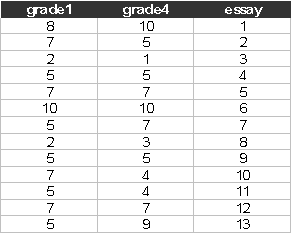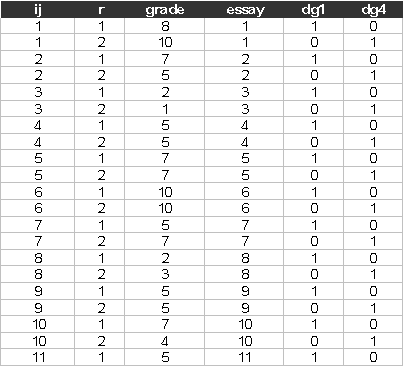Exercise C1, linear model
Johnson and Albert (1999) analysed data on the grading of essays by several experts. Essays were graded on a scale of 1 to 10 with 10 being excellent. In this exercise we use the subset of the data limited to the grades from graders 1 and 4 on 198 essays (grader1.dat). The same data were used by Rabe-Hesketh and Skrondal (2005, exercise 1.5).
Original data description
(grader1.dat)
Number of observations (rows): 198
Number of variables (columns): 3
Variables:
grade1= grade awarded by grader 1 {1,2,…,10)
grade4=grade awarded by grader 4 {1,2,….,10}
essay=essay identifier
The first few lines of the grader1.dat look like:

To use the data in Sabre we need to stack the data, with grade1 and
grade4 as a single column grade. We have done this for you and generated an
identifier to distinguish grade1 and grade4, i.e. dg4=1, if grade4 =1 and 0
otherwise.
Data description (grader2.dat)
Number of observations (rows): 396
Number of variables (columns): 6
Variables:
ij = essay identifier (1,2,…,198)
r = response (1,2)
grade= grade awarded
essay= essay identifier (this is a copy of ij)
dg1 = 1 if this is the grade from grader 1, 0 otherwise
dg4 = 1 if this is the grade from grader 4, 0 otherwise
The first few lines of the stacked data (grader2.dat) look like:

Start Sabre and specify transcript file:
out grader2.log
data ij r grade essay dg1 dg4
read grader2.dat
Suggested exercise:
(1) Estimate the linear model using Sabre
on grade, with just a constant and no other effects;
(2) Estimate the linear model, allowing for the essay random effect, use mass 64, this is a linear model and a lot of quadrature points are need to get a good approximation to the integrated likelihood. Are the essay effects significant? What impact do they have on the model?
(3) Re-estimate the linear model allowing for both the essay random effect and dg4.
(4) How do the results change as compared to a model with just a constant? Interpret your results.
References
Johnson, V. E., and Albert, J., H., (1999), Ordinal Data
Modelling, Springer,
Rabe-Hesketh, S., and Skrondal, A., (2005), Multilevel and Longitudinal Modelling using Stata, Stata Press, Stata Corp, College Station, Texas.